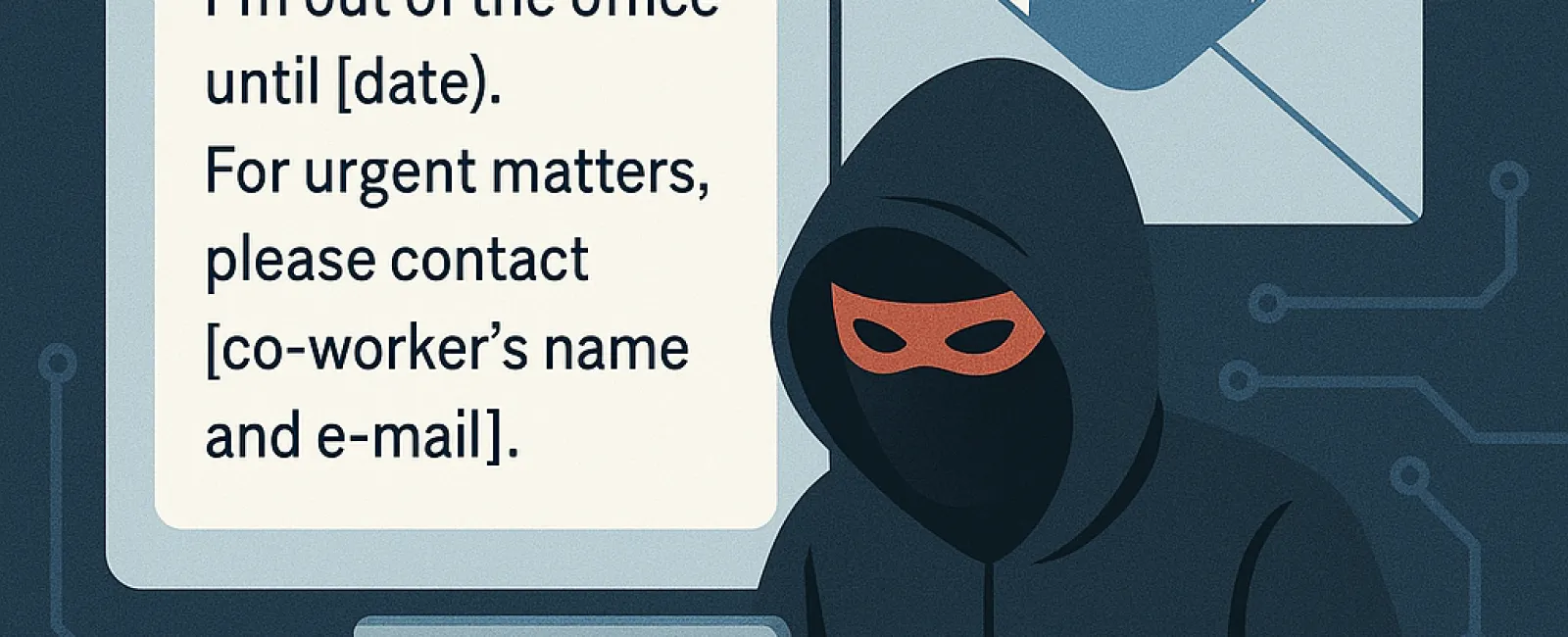June 16, 2025
You set it and forget it. Then, while you're preparing for vacation, your inbox automatically sends out a message:
"Hi there! I'm out of the office until [date]. For urgent matters, please contact [coworker's name and e-mail]."
It seems harmless, even convenient.
But this is exactly what cybercriminals look for.
Your auto-reply—a simple message meant to keep things organized—can actually provide valuable information to attackers seeking an easy entry point.
Let's examine what a typical out-of-office (OOO) message might reveal:
- Your name and job title
- The dates you're unavailable
- Alternate contacts with their e-mail addresses
- Internal team structures
- Even reasons for your absence ("I'm attending a conference in Chicago…")
This information gives cybercriminals two key advantages:
1. Timing: They know when you're away and less likely to detect suspicious activity.
2. Targeting: They know who to impersonate and who to target with scams.
This sets the stage for effective phishing or business e-mail compromise (BEC) attacks.
How The Scam Usually Plays Out
Step 1: Your auto-reply message is triggered.
Step 2: A hacker uses it to impersonate you or the alternate contact.
Step 3: They send a fake urgent request for a wire transfer, password, or sensitive document.
Step 4: Your coworker, caught off guard, believes the request is legitimate.
Step 5: You return from vacation to discover a large unauthorized payment has been made.
These incidents happen more often than you might realize and pose greater risks for businesses with frequent travelers.
If your company has employees who travel regularly—especially executives or sales teams—and someone else manages communications during their absence (such as a personal assistant or office administrator), this creates an ideal environment for cybercriminals:
- The assistant handles emails from multiple people
- They're accustomed to processing payments, documents, or sensitive requests
- They work quickly, trusting the authenticity of the messages they receive
One well-crafted fraudulent email can bypass defenses, resulting in costly breaches or fraud.
How To Protect Your Business From Auto-Reply Exploits
The answer isn't to eliminate OOO replies, but to use them carefully and implement safeguards. Consider these tips:
1. Keep It Vague
Avoid sharing detailed schedules or naming who covers for you unless absolutely necessary.
Example: "I'm currently out of the office and will respond when I return. For immediate assistance, please contact our main office at [main contact info]."
2. Train Your Team
Ensure everyone understands:
- Never act on urgent money or sensitive information requests based solely on email
- Always verify unusual requests through a secondary method, like a phone call
3. Implement E-mail Security Tools
Use advanced filters, anti-spoofing technology, and domain protection to reduce impersonation risks.
4. Use MFA Everywhere
Enable multifactor authentication on all email accounts to block unauthorized access even if passwords are compromised.
5. Work With An IT Partner Who Monitors Activity
A proactive IT and cybersecurity provider can spot suspicious login attempts, phishing campaigns, and abnormal behavior before harm occurs.
Want To Vacation Without Becoming A
Hacker's Next Target?
We help businesses build cybersecurity systems that
work - even when your team's out of office.
Click Here Or Give Us A Call At 816-233-3777 To Book A FREE 15-Minute Discovery Call.
We'll check your systems for vulnerabilities and show you how to lock down the risks, so you can actually enjoy that vacation without worrying about your inbox betraying you.



